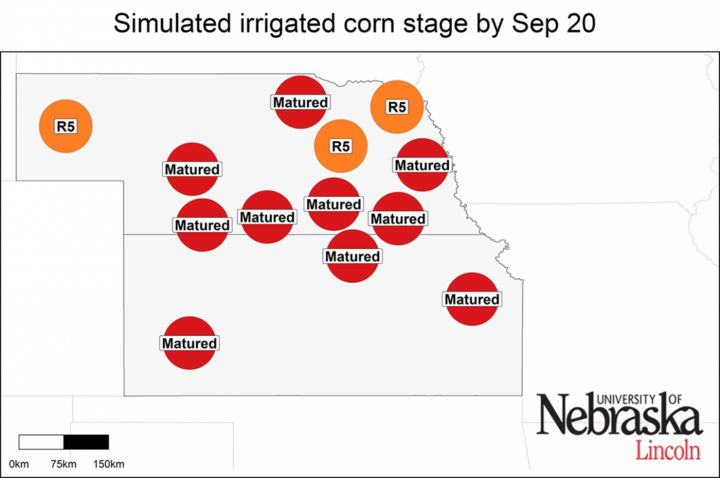This is the last article in a series that summarizes the simulated crop stages and yield forecasts across the Corn Belt. To evaluate, in “real-time,” the impact of this season’s weather on corn yield and its spatial variability across the Corn Belt, simulations of 2017 real-time crop stage were performed for 41 locations across the US Corn Belt using the UNL Hybrid-Maize crop model in collaboration with faculty and extension educators from 10 universities. Additionally, end-of-season forecasts of corn grain yield potential for all major irrigated corn-growing regions and for rainfed corn in Nebraska, Kansas, North Dakota, and Minnesota are provided. Data for the September 20 forecasts is in Table 1. Details on the UNL Hybrid-Maize crop model and the underpinning methodology to simulate phenology and forecast end-of-season yields, as well as on interpretation and uses of yield forecasts, is described in a previous article.
Weather and Crop Stages
The crop season continued with below-average nighttime temperatures, except for Nebraska where temperatures were near normal. Dry conditions prevailed across the region. Weather conditions during the last two weeks are shown in Figure 1. During the last week, corn has reached black layer at most locations in the southern and central fringes of Nebraska, Illinois, Indiana, and Iowa (Figure 2).

Figure 1. Daily solar radiation, maximum and minimum air temperature (Tmax and Tmin), total rainfall, and total reference grass-based evapotranspiration (ET) for August 30 to September 20, 2017. Vertical bars indicate the range for these variables based on 20+ years of weather records. The horizontal thick line indicates the long-term average and the red dots indicate the 2017 values.
(Links to larger version)

Above-Average Yields Prevailed for Both Irrigated and Rainfed Corn
Forecasted end-of-season irrigated yields are shown in Figure 3. About 80% of the irrigated sites exhibited above-average yields (ranging from +11% to +17% above the long-term average), except for western Nebraska (North Platte and Mc Cook) where forecasted yields are near average. The other site in western Nebraska where corn has not already matured (Alliance) will exhibit yields above or near average depending upon temperature during the next week.
Forecasted end-of-season yields for rainfed corn indicate above-average yield at two thirds of the sites (Figure 3). At these sites, yields are forecasted to be 13% to 40% above the long-term average. In contrast, the rest of the sites are forecasted to be near average (Concord and McCook, Nebraska and Hutchinson, Kansas) or below average (northwestern Minnesota and North Dakota).
Overall, it looks like a good year for corn for most sites for which we performed the yield forecasts, except for the northern fringe of the Corn Belt. Still, note that these forecasts do not take into consideration problems with stand emergence, hail/flooding damage, replanting situations, disease, or nitrate leaching. In fields negatively affected by these constraints, actual yields will be lower than estimates provided here. It is important to keep in mind that yield forecasts are not field-specific and, instead, represent an estimate of average on-farm yield for a given location and surrounding area in absence of the yield-reducing factors mentioned here. Likewise, crop stages and forecasted yields will deviate from the ones reported here in fields with planting dates or hybrid maturities that differ markedly from the ones used as the basis for the forecasts.
If you have questions about this story, please contact Patricio Grassini at pgrassini2@unl.edu or 402-472-5554.



